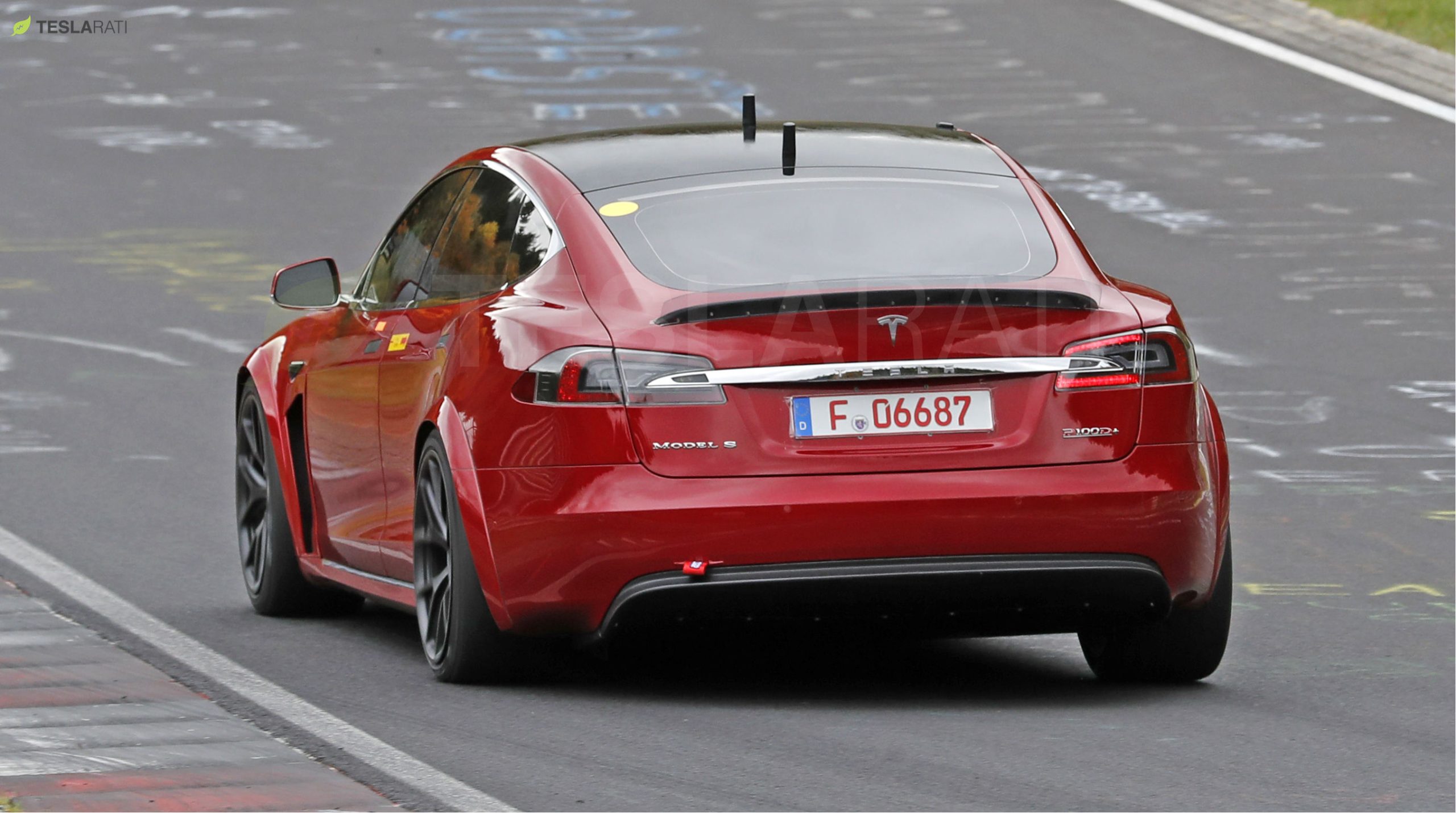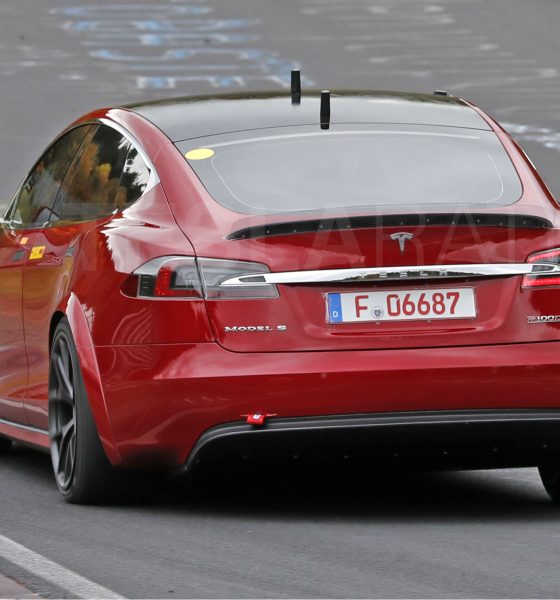

News
Tesla Model S Plaid spotted in Nurburgring testing with yoke and regular steering wheel
It took some time, but it appears that the time has finally come for Tesla to attempt a legitimate lap record around the world’s most iconic racetrack, Germany’s “Green Hell,” the Nürburgring. And if recent spy photos of a Model S Plaid are any indication, it seems that Tesla is currently testing its flagship sedan around the track using both the controversial steering yoke and a traditional steering wheel.
The sightings of the Tesla Model S Plaid at the Nürburgring were shared on social media on Monday, just after the EV maker held its second-quarter earnings call. Very little is known about Tesla’s plans for the vehicle in the nearly-13-mile racetrack this time around, though the absence of heavy modifications on the Model S Plaid suggested that the company may be looking to establish its own Nürburgring lap record.
Initial reports on the Model S Plaid’s recent outing to the Nürburgring pointed to the idea that Tesla may be looking to beat the Porsche Taycan Turbo’s 7:42 lap time, which the German all-electric sports car achieved back in 2019. This seems unlikely, however, as Porsche’s Nürburgring lap record for the Taycan was not officially sanctioned at all. Instead, the German automaker has confirmed that the Taycan’s impressive 7:42 lap was “one for ourselves that we use as a point of historical record.”
The new Tesla Model S Plaid at the Nürburgring looks like a stock vehicle, save for its brakes and brake calipers, which seem larger than the ones equipped in vehicles today. The car also seems to be fitted with Michelin Pilot Sport 3 tires.
Interestingly enough, the new Tesla Model S Plaid prototype in the Nürburgring was sighted with both a regular steering wheel and a steering yoke. This suggests that Tesla may be evaluating how the yoke performs in a track setting compared to a conventional steering wheel. This will be a very important point if Tesla is looking to release a “Track Pack” of sorts for the Model S Plaid, as a professional driver had already used a traditional steering wheel to win a prolific race using the flagship sedan.
Randy Pobst, a racing legend who contributed to the development of the Model 3 Performance’s Track Mode, famously opted to use a regular steering wheel during his Pikes Peak Hill Climb run in a Tesla Model S Plaid. The vehicle, which was modified by Unplugged Performance, was initially equipped with a steering yoke, which proved adequate during test runs in Laguna Seca. But when it came to Pikes Peak, with its treacherous cliffs and insane twists and turns, the racing legend opted to use a simple, regular steering wheel instead. This decision seemed to be the right choice, as the Model S Plaid ultimately dominated the 2021 Pikes Peak Hill Climb’s Exhibition Class.
Don’t hesitate to contact us for news tips. Just send a message to tips@teslarati.com to give us a heads up.

News
Tesla FSD fleet is nearing 7 billion total miles, including 2.5 billion city miles
As can be seen on Tesla’s official FSD webpage, vehicles equipped with the system have now navigated over 6.99 billion miles.

Tesla’s Full Self-Driving (Supervised) fleet is closing in on almost 7 billion total miles driven, as per data posted by the company on its official FSD webpage.
These figures hint at the massive scale of data fueling Tesla’s rapid FSD improvements, which have been quite notable as of late.
FSD mileage milestones
As can be seen on Tesla’s official FSD webpage, vehicles equipped with the system have now navigated over 6.99 billion miles. Tesla owner and avid FSD tester Whole Mars Catalog also shared a screenshot indicating that from the nearly 7 billion miles traveled by the FSD fleet, more than 2.5 billion miles were driven inside cities.
City miles are particularly valuable for complex urban scenarios like unprotected turns, pedestrian interactions, and traffic lights. This is also the difference-maker for FSD, as only complex solutions, such as Waymo’s self-driving taxis, operate similarly on inner-city streets. And even then, incidents such as the San Francisco blackouts have proven challenging for sensor-rich vehicles like Waymos.
Tesla’s data edge
Tesla has a number of advantages in the autonomous vehicle sector, one of which is the size of its fleet and the number of vehicles training FSD on real-world roads. Tesla’s nearly 7 billion FSD miles then allow the company to roll out updates that make its vehicles behave like they are being driven by experienced drivers, even if they are operating on their own.
So notable are Tesla’s improvements to FSD that NVIDIA Director of Robotics Jim Fan, after experiencing FSD v14, noted that the system is the first AI that passes what he described as a “Physical Turing Test.”
“Despite knowing exactly how robot learning works, I still find it magical watching the steering wheel turn by itself. First it feels surreal, next it becomes routine. Then, like the smartphone, taking it away actively hurts. This is how humanity gets rewired and glued to god-like technologies,” Fan wrote in a post on X.
News
Tesla starts showing how FSD will change lives in Europe
Local officials tested the system on narrow country roads and were impressed by FSD’s smooth, human-like driving, with some calling the service a game-changer for everyday life in areas that are far from urban centers.

Tesla has launched Europe’s first public shuttle service using Full Self-Driving (Supervised) in the rural Eifelkreis Bitburg-Prüm region of Germany, demonstrating how the technology can restore independence and mobility for people who struggle with limited transport options.
Local officials tested the system on narrow country roads and were impressed by FSD’s smooth, human-like driving, with some calling the service a game-changer for everyday life in areas that are far from urban centers.
Officials see real impact on rural residents
Arzfeld Mayor Johannes Kuhl and District Administrator Andreas Kruppert personally tested the Tesla shuttle service. This allowed them to see just how well FSD navigated winding lanes and rural roads confidently. Kruppert said, “Autonomous driving sounds like science fiction to many, but we simply see here that it works totally well in rural regions too.” Kuhl, for his part, also noted that FSD “feels like a very experienced driver.”
The pilot complements the area’s “Citizen Bus” program, which provides on-demand rides for elderly residents who can no longer drive themselves. Tesla Europe shared a video of a demonstration of the service, highlighting how FSD gives people their freedom back, even in places where public transport is not as prevalent.
What the Ministry for Economic Affairs and Transport says
Rhineland-Palatinate’s Minister Daniela Schmitt supported the project, praising the collaboration that made this “first of its kind in Europe” possible. As per the ministry, the rural rollout for the service shows FSD’s potential beyond major cities, and it delivers tangible benefits like grocery runs, doctor visits, and social connections for isolated residents.
“Reliable and flexible mobility is especially vital in rural areas. With the launch of a shuttle service using self-driving vehicles (FSD supervised) by Tesla in the Eifelkreis Bitburg-Prüm, an innovative pilot project is now getting underway that complements local community bus services. It is the first project of its kind in Europe.
“The result is a real gain for rural mobility: greater accessibility, more flexibility and tangible benefits for everyday life. A strong signal for innovation, cooperation and future-oriented mobility beyond urban centers,” the ministry wrote in a LinkedIn post.
News
Tesla China quietly posts Robotaxi-related job listing
Tesla China is currently seeking a Low Voltage Electrical Engineer to work on circuit board design for the company’s autonomous vehicles.

Tesla has posted a new job listing in Shanghai explicitly tied to its Robotaxi program, fueling speculation that the company is preparing to launch its dedicated autonomous ride-hailing service in China.
As noted in the listing, Tesla China is currently seeking a Low Voltage Electrical Engineer to work on circuit board design for the company’s autonomous vehicles.
Robotaxi-specific role
The listing, which was shared on social media platform X by industry watcher @tslaming, suggested that Tesla China is looking to fill the role urgently. The job listing itself specifically mentions that the person hired for the role will be working on the Low Voltage Hardware team, which would design the circuit boards that would serve as the nervous system of the Robotaxi.
Key tasks for the role, as indicated in the job listing, include collaboration with PCB layout, firmware, mechanical, program management, and validation teams, among other responsibilities. The role is based in Shanghai.
China Robotaxi launch
China represents a massive potential market for robotaxis, with its dense urban centers and supportive policies in select cities. Tesla has limited permission to roll out FSD in the country, though despite this, its vehicles have been hailed as among the best in the market when it comes to autonomous features. So far, at least, it appears that China supports Tesla’s FSD and Robotaxi rollout.
This was hinted at in November, when Tesla brought the Cybercab to the 8th China International Import Expo (CIIE) in Shanghai, marking the first time that the autonomous two-seater was brought to the Asia-Pacific region. The vehicle, despite not having a release date in China, received a significant amount of interest among the event’s attendees.








